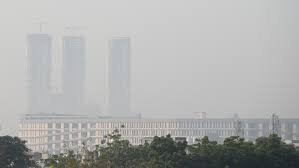 The air quality in Delhi plummeted on Tuesday post Diwali as residents flouted the Supreme Court-mandated time slots for bursting of firecrackers, even as the city government blamed the AAP dispensation in Punjab for the toxic haze over the national capital alleging forced stubble burning last night.
The air quality in Delhi plummeted on Tuesday post Diwali as residents flouted the Supreme Court-mandated time slots for bursting of firecrackers, even as the city government blamed the AAP dispensation in Punjab for the toxic haze over the national capital alleging forced stubble burning last night.
The city recorded its worst air quality on Tuesday since 2021, with PM2.5 levels reaching 488 micrograms per cubic metre in the 24 hours after Diwali, more than three times the pre-festival level of 156.6 micrograms per cubic metre. In neighbouring Haryana too, the air quality deteriorated with the AQI falling in the ‘very poor’ category in many areas, including in Gurugram, while it was in the ‘poor’ category in most parts of Punjab.
According to an analysis of Central Pollution Control Board (CPCB) data covering the period from 2021 to 2025, PM2.5 values in Delhi consistently spiked during Diwali night and early the next morning, with the 2025 post-Diwali reading of 488 micrograms per cubic metre being the most polluted period since 2021.
The data shows that in previous years, average PM2.5 levels rose from 163.1 to 454.5 in 2021, from 129.3 to 168 in 2022, from 92.9 to 319.7 in 2023 and from 204 to 220 in 2024.
The study by research and advisory group Climate Trends attributed the surge mainly to local emissions from firecrackers, stagnant winds of less than one metre per second and temperature inversion that traps pollutants close to the surface.
The high concentration of PM2.5 is due to local firecracker emissions across different parts of Delhi. Wind speed was extremely low, leaving no scope for dispersion, said SK Dhaka, professor at Rajdhani College, University of Delhi.



